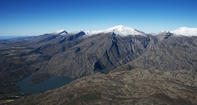It may not be a case of all roads leading to Ceres, but there are certainly more than enough routes that will take you to this scenic dorp in the Koue Bokkeveld.

Ceres arguably perches on the periphery of the Cape Winelands (or of the Cederberg if you’re heading north) and can be accessed via the Route 62; over Michell’s Pass via the N1, R43 and R46), along the Theronsberg Pass (from Touws River on the R46) and via Gydo Pass (from Citrusdal, along the R303).
Now that you know how to get to this dorp famed for its fruit juices, how about a few reasons to actually go there? Snow is probably the key purpose luring most Capetonians to this region every winter, as Ceres’ snow-capped peaks are easily accessible. It is also the Western Cape’s primary deciduous fruit region, and cherry-picking is a popular pastime over December.
Arts and crafts shops, eateries, farm stalls, rock art sites, private nature reserves such as Kagga Kamma, snowboarding, mountain biking … the list of other attractions is pretty impressive, too. The days are generally sunny in the Ceres Valley, even in winter when snow covers the high peaks, and it is no wonder the town has been dubbed South Africa’s own ‘Little Switzerland’.
The Matroosberg Private Nature Reserve boasts a number of gravel roads, 4x4 tracks and trails perfect for mountain biking, hiking and trail running, plus the highest off-road 4x4 trail in the Cape.
Did You Know? The first settlers to cross the Witzenberg Mountains arrived in the Ceres Valley in 1729, but Michell’s Pass was only constructed more than a 100 years later. You can go and explore this ‘Forgotten Highway’. The Valley of Ceres was named for the Roman goddess of Agriculture.
 This is about as hip, hot and happening as a day in the mountains will ever get! Live your personal Peter Stuyvesant dream by boarding a hel...
This is about as hip, hot and happening as a day in the mountains will ever get! Live your personal Peter Stuyvesant dream by boarding a hel... The completion of the railway line between Ceres and Wolseley in 1912 provided a tremendous boost to the fruit industry, and Ceres is today ...
The completion of the railway line between Ceres and Wolseley in 1912 provided a tremendous boost to the fruit industry, and Ceres is today ... The trailhead is at the old farmhouse of Eselfontein Farm, but you can link onto the route pretty much anywhere on the farm. The initial sec...
The trailhead is at the old farmhouse of Eselfontein Farm, but you can link onto the route pretty much anywhere on the farm. The initial sec... Take the R303 from Ceres, up Gydo Pass, past the Winterhoek mountains and Op Die Berg, through the Koue-Bokkeveld then over the Kouebokkevel...
Take the R303 from Ceres, up Gydo Pass, past the Winterhoek mountains and Op Die Berg, through the Koue-Bokkeveld then over the Kouebokkevel... If you’d like to get away from the hustle and bustle of the city, why not escape to the country from Cape Town into the Cape Winelands and...
If you’d like to get away from the hustle and bustle of the city, why not escape to the country from Cape Town into the Cape Winelands and...